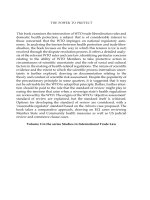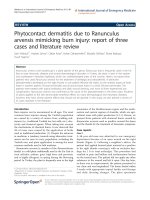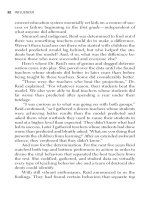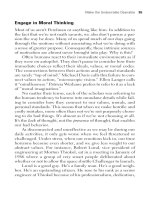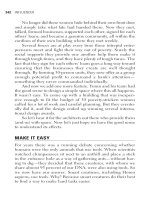Influencer The Power to Change Anything by Kerry Patterson, Joseph Grenny, David Maxfield and Ron McMillan_5 pptx
Bạn đang xem bản rút gọn của tài liệu. Xem và tải ngay bản đầy đủ của tài liệu tại đây (764.76 KB, 21 trang )
This page intentionally left blank
75
Make Change Inevitable
Who shall set a limit to the influence of a human being?
—Ralph Waldo Emerson
L
et’s say that you’ve discovered the vital behaviors that
need to be enacted to help resolve a profound and per-
sistent problem you’re facing. You’ve also helped every-
one involved see the need for change. Now how do you actually
go about making that change happen?
To answer this question, let’s return to Guinea worm dis-
ease eradication efforts in North Africa—this time to a town in
Nigeria. Imagine that you’re following General Gowon. He has
been to this village to help dislodge the flawed beliefs that have
kept villagers from changing their behavior. Minds have been
changed. Certainly changing behavior will be a snap. So what’s
the next step?
Most of us have our favorite influence methods—just pass
a law, just threaten a consequence, or just offer a training pro-
gram. The problem with sticking to our favorite methods is not
that the methods are flawed per se; it’s that they’re far too sim-
plistic. It’s akin to hiking the Himalayas with only a fanny pack.
There’s nothing wrong with Gatorade and a granola bar, but
you’ll probably need a lot more. Bringing a simple solution to
a complex and resistant problem almost never works.
Nevertheless, people bet on single-source influence strate-
gies all the time. For instance, ask leaders how they’re planning
to change their employees from being clock-punchers to qual-
ity zealots, and they’ll point to their new training program—
the same one that they’re convinced drove General Electric’s
Copyright © 2008 by VitalSmarts, LLC. Click here for terms of use.
76 INFLUENCER
stock through the stratosphere in the 1990s. The training con-
tent might provide a start, but when it comes to creating a cul-
ture of quality, it’ll take a great deal more than a training class.
Ask politicians what they’re doing to fight crime, and they’ll tell
you that they’re working hard to secure harsher sentences for
felony convictions. Also not enough to have much of an
impact. Ask community leaders what steps they’re taking to
stem the growing plight of childhood obesity, and they’ll sing
the praises of their latest pet project—removing candy
machines from schools.
And let’s be honest. How many of us haven’t yearned for a
quick fix for our own problems? A miracle diet pill, a magical
marriage solution, or a $500 set of DVDs that promises finan-
cial freedom. Just give us that one thing, and we’re ready to roll.
But it takes a combination of strategies aimed at a handful
of vital behaviors to solve profound and persistent problems. In
fact, this is the core principle demonstrated by virtually all
the change masters we studied. No single strategy explained
their success. In fact, it became quite evident that individuals
who succeed where others have routinely failed overdetermine
success—that is, they bring more influence strategies into play
than they might assume would be the minimum required for
success. They leave nothing to chance.
This could sound discouraging. In Chapter 2 we shared the
good news that it often takes only a few vital behaviors, routinely
enacted, to bring about massive and lasting changes. Now we’re
adding the idea that, while you need to affect only a few behav-
iors, behind each you’ll uncover a number of forces that either
encourage or discourage the right action and an equal number
of forces that either enable or block the correct behavior. Ignore
these varied and sundry forces at your own peril.
Fortunately there’s additional good news. We now know
enough about the forces that affect human behavior to place
them into a coherent and workable model that can be used to
organize our thinking, select a full set of influence strategies,
Make Change Inevitable 77
combine them into a powerful plan, and eventually make
change inevitable.
MASTER SIX SOURCES OF INFLUENCE
Here’s how the model works. As we’ve said before, virtually all
forces that have an impact on human behavior work on only
two mental maps—not two thousand, just two. At the end of
the day a person asks, “Can I do what’s required?” and, “Will
it be worth it?” The first question simply asks, “Am I able?” The
second, “Am I motivated?” Consequently, no matter the num-
ber of forces that affect human action—from peer pressure in
a junior high school to making citizens aware of the cost of illit-
eracy in a barrio to offering a class on anger management in
Beverly Hills—all these strategies work in one of two ways.
They either motivate or enable a vital behavior. Some do
both.
Motivation and ability comprise the first two domains of
our model.
We further subdivide these two domains into personal,
social, and structural sources. These three sources of influence
reflect separate and highly developed literatures—psychology,
social psychology, and organization theory. By exploring all
three, we ensure that we draw our strategies from the known
repertoire of influence techniques.
Let’s quickly look at the range of influence sources effective
influencers draw upon. Don’t worry if they aren’t crystal clear
at this point. Over the next six chapters, we explain the various
influence methods in detail. In fact, you’re likely to see how
many of them account for improvements you’ve made in your
own life. But for now, you’ll know how to consciously draw upon
this robust set of sources any time you need.
At the personal level, influence masters work on connect-
ing vital behaviors to intrinsic motives as well as coaching the
specifics of each behavior through deliberate practice. At the
78 INFLUENCER
group level, savvy folks draw on the enormous power of social
influence to both motivate and enable the target behaviors. At
the structural level, top performers take advantage of methods
that most people rarely use. They attach appropriate reward
structures to motivate people to pick up the vital behaviors. And
finally, they go to pains to ensure that things—systems,
processes, reporting structures, visual cues, work layouts, tools,
supplies, machinery, and so forth—support the vital behaviors.
With this model at the ready, influence geniuses know
exactly which forces to bring into play in order to overdeter-
mine their chances of success.
Pictorially, we can display these six sources of influence in
the following model.
Design
Rewards and
Demand
Accountability
Change the
Environment
Harness
Peer Pressure
Find Strength
in Numbers
Make the
Undesirable
Desirable
Surpass
Your Limits
MOTIVATION
PERSONAL
SOCIAL
STRUCTURAL
ABILITY
Make Change Inevitable 79
To better understand how each of these six sources oper-
ates, let’s return to the village in Nigeria where we show up with
visions of annihilating the nasty Guinea worm. We know that
villagers need to enact only three vital behaviors in order to
eliminate the worm. First, people must filter their water. How
hard could that be? Second, should someone still become
infected, he or she must not make contact with the public water
supply until the infection has run its course. Just stay away from
the water. And third, if a neighbor is not filtering water or
becomes infected, the villagers must confront him or her.
Since we know the three behaviors that will eradicate the
Guinea worm, it sounds as if our influence project won’t be
particularly complicated. However, before we start giving
heartfelt speeches and handing out four-color pamphlets, let’s
see how each of the six sources of influence affects this actual
project.
Source 1: Personal Motivation. When the Guinea worm is exit-
ing a victim’s body, the pain is absolutely excruciating. Since
victims can’t merely yank the worm out of their arm or leg with-
out the worm breaking and causing a horrific infection, they’re
forced to wind the parasite around a stick and slowly edge it
out over a couple of weeks—or even a couple of months.
There’s only one source of relief during this prolonged ordeal,
and that’s for victims to soak their painful sores in water. That
means that individuals are personally motivated to do exactly
the opposite of one of the vital behaviors—stay away from the
water. If you don’t deal with personal motivation, your influence
plan will fail.
Source 2: Personal Ability. Many of the villagers don’t know
how to properly filter water. They’ve been trying since General
Gowon left, but the Guinea worm disease is still rampant. When
they take the steps to filter the water, they’ll carelessly slop over
a splash here and a drop there, infecting the water supply and
continuing the infestation. Or they’ll transfer filtered water into
80 INFLUENCER
a pot that’s still moist with unfiltered water. They’ll need train-
ing to enhance their personal ability.
Source 3: Social Motivation. Next, when you sit down with the
locals to teach them how to eliminate the Guinea worm,
nobody is going to pay very much attention to your advice.
You’re an outsider and as such simply can’t be trusted. You may
be in good with the chief, but there are three tribes in the vil-
lage, two of which resent the chief and will resist anything you
offer because he’s behind it. Unless circumstances change, you
have a serious problem with social motivation.
Source 4: Social Ability. People in a community will have to
assist each other if they hope to succeed. When it comes to an
outbreak, nobody can make it on his or her own. If ever there
was a circumstance where the expression “It takes a village”
applies, this is it. For example, if someone comes down with
the worm, others may have to fetch water for him or her. And
when it comes to filtering, locals often have to buddy up in
order to have enough pots to both fetch and filter water. If locals
don’t enlist the help of others, you’ll be missing the key factor
of social ability.
Source 5: Structural Motivation. Given the villagers’ current
financial circumstances (living hand-to-mouth), individuals
who become infected can’t afford to stay away from work. This
forces them to labor in and around the water supply. Quite sim-
ply, to put food on the table, they’ll need to fetch water for both
their crops and livestock. This means that the formal reward sys-
tem is at odds with the three vital behaviors. Infected people
earn money only if they work near the water source. If you don’t
compensate for the existing reward structure, victims will be
compelled to serve their families at the expense of the entire vil-
lage. Try to move forward without addressing structural motiva-
tion, and your influence won’t reach far.
Make Change Inevitable 81
Source 6: Structural Ability. Lastly, locals don’t have all the tools
they need to filter the water or to care for their wounds in a way
that keeps them away from the community water source. Worse
still, the layout of the village makes access to the public water
supply so easy and natural that it’s enormously tempting for vic-
tims to merely plunge their aching arm or leg into the water—
at the peril of everyone else. If you don’t work on this last source
of influence, structural ability, you’re also likely to fail.
MAKE USE OF ALL SIX SOURCES
Now that we’ve explored how all six sources of influence came
into play with the Guinea worm project, it’s easy to see why
influence geniuses take pains to address each source when
going head to head with a profound and persistent problem.
Leave out one source, and you’re likely to fail.
Throughout the remainder of this book—to demonstrate
how the six sources can be applied in combination—we
explore what Dr. Silbert has done with each of these influence
tools to help transform lifelong felons into productive citizens.
At the home level, we follow an individual who is trying to lose
weight and see how each of the six sources might apply to this
widespread (pun intended) problem. Finally, we’d ask you to
pick a challenge of your own and read each of the six chapters
with that problem in mind. Then fashion your own six-source
influence strategy. Do it correctly, and like Dr. Silbert and
dozens of other successful influencers, you’ll solve problems
that have had you and others stumped for years.
This page intentionally left blank
83
4
Make the
Undesirable Desirable
PERSONAL MOTIVATION
Hard work pays off in the future. Laziness pays off now.
—Steven Wright
Design
Rewards and
Demand
Accountability
Change the
Environment
Harness
Peer Pressure
Find Strength
in Numbers
Make the
Undesirable
Desirable
Surpass
Your Limits
MOTIVATION
PERSONAL
SOCIAL
STRUCTURAL
ABILITY
Copyright © 2008 by VitalSmarts, LLC. Click here for terms of use.
84 INFLUENCER
I
n this chapter we examine the first and most basic source
of motivation—intrinsic satisfaction. This source of influ-
ence asks the question: Do individuals take personal satis-
faction from doing the required activity? That is, does enacting
the vital behavior itself bring people pleasure? If not, how can
you get people (yourself or others) to do things they currently find
loathsome, boring, insulting, or painful?
For example, how could you ever convince a lifetime drug
addict to withstand the pain of withdrawal long enough to get
clean? Or for that matter, how might you motivate a terrified
nurse to tell an intimidating doctor that he needs to wash his
hands more thoroughly before examining patients?
If you can’t find a way to change a person’s intrinsic
response to a behavior—if you can’t make the right behaviors
pleasurable and the wrong behaviors painful—you’ll have to
make up for the motivational shortfall by relying on external
incentives or possibly even punishments. You know what that’s
like. Your son hates taking out the garbage, so you load on the
“pretty pleases” or threaten to ground him through puberty.
Your employees despise completing quality checks, so you
have to harp on them every few hours. The guy who owns the
empty lot next to your house hates keeping it neat (as required
by the community code), so you have to keep ratting him out
to the local authorities. And guess what. If you stop grounding,
harping, or ratting folks out, they’ll stop doing what they’re sup-
posed to be doing because they don’t like doing it.
The point? If we could only find a way to make a healthy
behavior intrinsically satisfying, or an unhealthy behavior
inherently undesirable, then we wouldn’t need to keep apply-
ing pressure—forever. The behavior would carry its own moti-
vational power—forever.
So here’s our first question. Can you actually change how
humans experience a behavior? Naturally, we’re not talking
about simply adding a spoonful of sugar. That’s cheating. We’re
asking whether it’s possible to change the meaning of a behav-
Make the Undesirable Desirable 85
ior itself from loathsome to gratifying, from pleasurable to dis-
gusting, or from insulting to inspiring.
It sounds impossible, but if you ask gifted influencers, their
unequivocal answer will be, of course you can. And you
must.
TUESDAY AFTERNOON
It’s 3:17 Tuesday afternoon. Terri is carrying a CD loaded with
financial data from the accounting office to the Delancey
Street Restaurant. The manager asked her to bring it over
ASAP, so she logged into her computer, burned the data onto
the disc, and headed for the restaurant.
What surprises Terri is how quickly her feet are moving. She
can’t recall the last time they moved this fast. From the time she
was nine, she had perfected a purposefully casual gait. She took
great pride in her “I’m okay/you suck” approach to life. No mat-
ter that this attitude had landed her in jail for most of her
adolescent years. No matter that it earned her a manslaughter
conviction after someone looked at her sideways in a bar.
Nobody was going to tell her what to do. Nobody.
So why is Terri walking so fast now? It’s been 19 months
since she was offered a tour at Delancey Street rather than serv-
ing her last five years in prison. Every semester, Terri has
attended Delancey’s graduation ceremony. It’s a grand gather-
ing where all 500 residents of the San Francisco campus crowd
into the main hall to celebrate each other’s progress. The first
two times Terri was recognized for her accomplishments, she
stared at the floor and ignored whatever they were saying
about her. “Who gives a flying leap that I now know how to set
a frigging table? This is all a stupid game, and I’m not playing
it!” When the applause for Terri had died down, she walked
back to her chair, unaffected.
But last week they talked about her diploma and her pro-
motion to crew boss. She looked over at Dr. Silbert, who was
86 INFLUENCER
waving her arms and barking out Terri’s amazing accomplish-
ment. And Terri made the mistake of listening to what Silbert
said—just for a second. Then came the wave of applause. Terri
looked around the room and caught the eyes of a few of her
crew members. Then she looked quickly back down at the
floor. Her legs felt weak when she walked back to her chair.
“I’m not sure what that is,” she mumbled to herself. “I’m
probably just hungry.” She ate a candy bar.
Now as Terri rushes to the restaurant, she looks down
again, only this time at her legs. They’re moving so fast it’s as
if they have a mind of their own. And then she lifts her hand
to her cheek and feels something wet. “I don’t do this. What
the hell is this?” Terri is crying.
MAKE PAIN PLEASURABLE
So, what has happened to Terri? Is she actually enjoying work
that she once despised? It’s almost as if she enjoys accomplish-
ing something. She’s found pleasure in her work. Better still, she’s
learned to care about something. In Terri’s own words, “After
thinking about it all afternoon, I finally realized, I was crying
because I cared. I cared that I got the disc to Lionel. I cared.”
If that’s true, if Terri has found a way to enjoy something
that she had previously disliked, what might your average per-
son extract from this? For example, what mysterious trick might
you pull in order to help your son want to do his chores? Could
this same magic potion make a team enjoy the work involved
in reducing errors to below 3.4 per million? And can you use
Terri’s mystical elixir to make eating mini carrots as enjoyable
as wolfing down a slice of chocolate cream pie?
Actually, people do learn ways to take pleasure from almost
any activity, even if an activity isn’t inherently satisfying.
Psychiatrist M. Scott Peck makes this point rather bluntly:
Just because a desire or behavior is natural, does not
mean it is . . . unchangeable. . . . It is also natural . . .
Make the Undesirable Desirable 87
to never brush our teeth. Yet we teach ourselves to do the
unnatural. Another characteristic of human nature—per-
haps the one that makes us more human—is our capac-
ity to do the unnatural, to transcend and hence transform
our own nature.
The promise here is significant. If we can find a way to change
the feeling associated with a vital behavior, we can make com-
pulsive bad habits feel as disgusting as going to bed with gritty
teeth. And we can make formerly unappealing activities become
as satisfying as brushing our teeth. And if you miss this important
concept, whenever you try to motivate yourself or others to
change behavior, you’ll turn to perks and wisecracks rather than
find ways to make the activity itself more inherently attractive.
To see how to accomplish all of this transcending and trans-
forming, we must first understand where our likes and dislikes
come from. Once we have a handle on the origins of pleasure
and pain, savvy influencers will teach us what to do with this
knowledge.
Many of our preferences come from our biology. We have
powerful desires for things like food, drink, warmth, rest, sex,
and air. But biology isn’t always destiny. Despite our hard-
wiring, some biological drives—or at least their impacts on our
preferences—are surprisingly easy to change. You’ll recall that
back in the early 1900s, students of Ivan Pavlov completed
dozens of studies that used buzzers, metronomes, or bells to sig-
nal dogs that food was coming. After being fed on cue several
times, the dogs would begin to salivate whenever they heard
the signal.
This kind of learning, using a neutral stimulus to signal a
reward or punishment, is called classical conditioning. What’s
relevant to our discussion of changing what people derive sat-
isfaction from is that classical conditioning causes dogs and
people to “like” or “hate” the bell. When we use a neutral stim-
ulus to signal a strong positive or negative event, we nudge it
off neutral.
88 INFLUENCER
Brian Wansink, a consumer behavior psychologist, shows
how classical conditioning influences something as basic as
food preferences. He surveyed World War II veterans who had
served in the South Pacific. He discovered that about a third
of them loved Chinese food, while another third hated it. What
made the difference? They had all eaten Chinese food during
the war—it was all they had to eat. The third who had experi-
enced heavy combat during the periods where they ate
Chinese food hated it. The third who had been away from the
front lines loved it. The soldiers had been classically condi-
tioned to love or hate Chinese food, and these preferences
remained 50 years later. In short, the preference was both
learned and durable.
While Pavlov’s experiments linked bells to something pos-
itive (food), other researchers used cues to signal something less
desirable—say an electric shock. To no one’s surprise, it turns
out that fear and pain create even more dramatic changes in
preferences. Remember the book A Clockwork Orange? Alex,
a particularly nasty hoodlum, is given “aversive therapy.” Prison
doctors play images of violence choreographed to Beethoven’s
Ninth Symphony while giving Alex drugs that make him
severely nauseous. The aversive therapy worked so well that
Alex could no longer defend himself—or enjoy Beethoven.
But, alas, this is all more of a curiosity than a helpful tool.
Although negative associations can indeed cause profound
change in preferences, you won’t find effective influencers using
aversive or other aggressively manipulative methods. Shock col-
lars all around, right? Wrong. They avoid painful techniques
because they are ethical, principled, and nice people.
So, if we shouldn’t poke people with sharp sticks as a way
of propelling them away from their inappropriate behavior,
what’s left? Actually, there are two very powerful and ethical
ways of helping humans change their reaction to a previously
neutral or noxious behavior: creating new experiences and
creating new motives.
Make the Undesirable Desirable 89
CREATE NEW EXPERIENCES
A little knowledge is a dangerous thing. Sometimes people
loathe the very thought of a new behavior because they lack
adequate information to judge it correctly. They imagine what
a new behavior will feel like, and their predictions come up
negative. Unfortunately, they’re often wrong.
Get People to Try It
This problem of guessing incorrectly about how an activity
might make one feel is neither odd nor inconsequential. The
average human being is actually quite bad at predicting what
he or she should do in order to be happier, and this inability
to predict keeps people from, well, being happier. In fact, psy-
chologist Daniel Gilbert has made a career out of demonstrat-
ing that human beings are downright awful at predicting their
own likes and dislikes. For example, most research subjects
strongly believe that another $30,000 a year in income would
make them much happier. And they feel equally strongly that
adding a 30-minute walk to their daily routine would be of triv-
ial import. And yet Dr. Gilbert’s research suggests that the
added income is far less likely to produce an increase in hap-
piness than the addition of a regular walk.
Dr. Silbert confronts this inability to predict happiness every
single day. It’s her job to ask new residents at Delancey Street to
do things that, to them, sound painful, boring, or both. For exam-
ple, lifetime criminals have no idea what a law-abiding life
might be like. When they do try to imagine it, they make some
very predictable errors. They assume that it will be very much
like their present life—minus the fun. You know, cleaning
toilets while giving up the excitement of crime or the stimula-
tion of drugs. They’re unable to imagine the pleasure associated
with getting a raise, owning a home, or any of a thousand other
parts of a law-abiding life they’ve never experienced.
90 INFLUENCER
Silbert could spend a lot of time painting a picture of the
Delancey vision. “Trust me,” she could say, “you’re gonna love
it. By the time you’re out of here, you’ll have a high school
diploma. You’ll be literate. You’ll have gone to concerts and
museums. You’ll have mastered three different trades and tried
a dozen others. You’ll have a whole new set of friends. Just sign
here.”
Right.
These arguments are easy to make but hard to sell because
they involve verbal persuasion and the people you’re talking to
don’t understand the language. You’re describing activities
and outcomes for which they have no frame of reference, and
you’re then asking them to make enormous immediate sacri-
fices (no gang, no drugs, no freedom) in order to achieve them.
It won’t work. It can’t work.
Silbert realizes that it’ll take a while before new residents
personally experience the benefits of a new life. She explains,
“After they get their high school equivalent, we offer two-year
degrees through San Francisco State. Some even get a BA. But
early on, residents hate the discipline that it takes to study. We
also go with them to museums, operas, plays. Oh, believe me,
they whine like crazy. They don’t want to go. But I just keep
saying, ‘You can hate Chinese food, but not until after you’ve
had Chinese food.’ Coming in, our residents hate everything.
But of course they’ve never done anything!”
So Dr. Silbert simply plods forward, demanding that resi-
dents try studying for a class, attending the opera, mentor-
ing another student, and so forth. Experience has taught
her that if residents try new behaviors, they end up liking
many if not most of them. Okay, perhaps few become opera
fans. Nevertheless, over 90 percent come to enjoy dozens of
behaviors they never would have imagined they’d one day
enjoy.
Silbert sticks with it until that Tuesday at 3:17 (Terri’s
experience) finally hits. She says it happens to virtually every-
Make the Undesirable Desirable 91
one at Delancey. There comes a day when residents become
a person they’ve never met—and they like it. They care.
They take satisfaction in accomplishment. They’ve discovered
the intrinsic satisfaction that comes with living a law-abiding
life.
The “try it, you’ll like it” strategy can be further aided by
the use of models. Many of our influence masters have
found that vicarious experience can work in situations where
they can’t get people to try a vital behavior based on faith alone.
For example, as you recall from an earlier chapter, Miguel
Sabido inspired hundreds of thousands of illiterate Mexicans
to sign up for literacy programs by engaging them in the story
of a man just like them—someone who was “too old to learn.”
Someone who was initially unwilling to bear the shame of sit-
ting in a class with much younger people and admitting his
“defect.”
Week after week as Sabido’s audiences experienced the
journey to literacy and vicariously experienced what it would
be like to be able to read, it began to mean something. They
imagined just how entertaining life would be with access to fas-
cinating books. They saw the effect a grandparent could have
on grandchildren. They felt what it would be like to have the
sense of pride that comes from graduating from literacy class.
And eventually they shut down the streets of Mexico City with
their deluge of requests for literacy information that was adver-
tised on the series.
What do you think happened when all these new people
arrived at their first reading class? They quickly found that
learning to read was difficult and not always a whole lot of fun.
They couldn’t go home that night and read to their grandchil-
dren. Fortunately, the characters in the television show had
demonstrated the difficult side of the learning process, so it
wasn’t a huge surprise. People understood the pleasures of read-
ing, but knew they’d have to work to become proficient before
these pleasures would be theirs.
92 INFLUENCER
Make It a Game
Let’s look at another way of transforming neutral or detest-
able behavior into something enjoyable. Let’s say an indi-
vidual tries the new behavior but still doesn’t like it all
that much. Now what? Take hope from the fact that humans
invest themselves in a wide variety of pursuits that on the
surface don’t look particularly engaging or rewarding, and yet
somehow they extract enjoyment. So, what’s the trick?
It turns out that one of the keys to motivation lies in a force
just barely outside the activity itself. It lies in the mastery of
ever-more challenging goals. Mihalyi Csikszentmihalyi, a
researcher at the University of Chicago, has devoted his career
to what he has come to call “flow” or the feeling of enjoyment
that comes from losing yourself in an engrossing activity. He
has discovered that almost any activity can be made engaging
if it involves reasonably challenging goals and clear, frequent
feedback. These are the elements that turn a chore into some-
thing that feels more like a game.
For example, imagine that you removed the scoreboard
from a basketball court. How long would you expect fans to
stick around without knowing the score? How long do you
think the players would run breathlessly up and down the court
destroying their knees with every step? Much of what we do to
transform intrinsically unpleasant behavior into something
enjoyable is merely to turn it into a game.
Keeping score produces clear, frequent feedback that
can transform tasks into accomplishments that, in turn,
can generate intense satisfaction. The designers of many of
today’s video games have an intuitive feel for Dr. Csiks-
zentmihalyi’s research and have used it to create games
that call for highly repetitive activities that end up being
amazingly addictive as individuals strive for that next level of
achievement.
Make the Undesirable Desirable 93
CREATE NEW MOTIVES
The “try it, you’ll like it” strategy assumes that people will find
a new activity rewarding if they just give it a chance. But many
activities produce few natural rewards. They’re also very diffi-
cult to transform into a game through constant feedback.
What can you do when neither the activity itself nor the natu-
ral feedback the activity produces are inherently pleasant or
motivating?
This is an important question because many important
human endeavors fall into this “not inherently pleasant” cate-
gory. For example, if you’re a villager with five Guinea worms
burning their way out of your body, your sole focus will be on
finding relief. You’re in pain, and you want it to stop. “Try gut-
ting it out, and you’ll like it” won’t work here. Adding a score-
board (how long can you stay away from the water?) is equally
unlikely to change your experience. So what’s left? How can
you help people not want to run and plunge their body into
the pain-relieving water supply when they crave relief right
now?
Connect to a Person’s Sense of Self
Unpleasant endeavors require a whole different sort of motiva-
tion that can come only from within. People stimulate this
internal motivation by investing themselves in an activity. That
is, they make the activity an issue of personal significance.
Succeeding becomes more than the challenge of reaching the
next level on a video game—it becomes a measure of who they
are. They set high standards of who they’ll be, high enough to
create a worthy challenge, and then they work hard to become
that very person.
For example, meet Grigori Perelman. Grigori worked his
head off for years in his dingy apartment in St. Petersburg,
94 INFLUENCER
Russia. A few years ago the grizzled and gawky math wiz did the
formerly impossible. He solved the Poincare Conjecture—a
problem no other mathematician had been able to solve despite
a century of intense worldwide effort. It’s a problem so arcane
that most of us wouldn’t even understand the question.
Here’s what’s interesting about Perelman. He did it just for
fun. The only way the world discovered that Grigori had solved
the problem was that he went to the minimal trouble of post-
ing the solution on a Web site. After spending years of his life
in intense concentration, with no compensation or reward,
Perelman celebrated his dramatic accomplishment with a Web
posting.
What kept Perelman going for all those years? It certainly
wasn’t the fame or fortune. His obscure Web posting caught the
attention of the judges of mathematics’ version of the Nobel
Prize. And for that reason alone he was offered the Field
Medal for Mathematics—and a $1 million prize. Perelman
refused both. He was on to his next task and wanted only to be
left alone. He sits today in his cramped St. Petersburg apart-
ment working on another problem.
Perelman is unique in his mathematical skills, but his
source of motivation is so common and so profound that every
influence genius needs to master its use. The most powerful
incentive known to humankind is our own evaluation of our
behavior and accomplishments. When people are able to meet
their personal standards, they feel validated and fulfilled. They
also feel as if they’re living up to the image of who they want
to be.
In this particular case, Perelman probably exacted pleasure
from all three of the intrinsic sources we just discussed. He rev-
eled in the accomplishment, loved the challenge of the game,
and took pleasure in acting true to the vision of who he wanted
to be. When Perelman conquered the Poincare Conjecture, he
felt a satisfaction so deep and pure that the million-dollar prize
would have only spoiled it for him.



